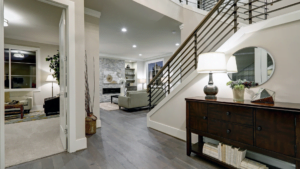Smart and Not-So-Smart Renovation Choices
The desire to make changes to one’s property is common among new homeowners. Whether driven by evolving family needs or changing design preferences, many eventually opt for a remodel. Some homeowners choose to update their property before putting it on the market to enhance its potential resale value.
Regardless of your motivations for embarking on a home improvement project, it is important to assess how the money you put in will affect your home’s overall worth. To assist you in making informed decisions, we have analyzed six popular home renovations to determine which ones typically yield the best and worst returns on investment. Before engaging in any renovation work or contracting services, consult this list to gauge whether your remodeling endeavors will pay off when it comes time to sell your home.
Renovations with Financial Rewards
Revamp your living space with these three popular home improvement projects that not only enhance your home’s functionality and aesthetics but also provide a significant return on investment. By carefully selecting upgrades for your property, you can boost its value in the long run. (smart renovation choices).
Minor Kitchen Remodel – Definitely one of the Smart Renovation Choices
 The kitchen is commonly known as the “heart of the home,” and this title holds true for various reasons. Originally designated for food preparation, it has evolved into a multifunctional space. Nowadays, many families enjoy their meals in the kitchen, use it as a hub for schoolwork and children’s creative projects, and find it to be a central gathering spot for entertaining guests.
The kitchen is commonly known as the “heart of the home,” and this title holds true for various reasons. Originally designated for food preparation, it has evolved into a multifunctional space. Nowadays, many families enjoy their meals in the kitchen, use it as a hub for schoolwork and children’s creative projects, and find it to be a central gathering spot for entertaining guests.
Given the amount of time spent in kitchens, it’s natural to consider updates and improvements to align with our evolving needs and style preferences. A minor kitchen renovation stands out as a highly beneficial investment for homeowners. According to Remodeling Magazine’s Cost vs. Value Report, such a renovation typically yields an impressive 80.5% return on investment.
To ensure a successful kitchen remodel, it’s essential to maintain a balance in the scale of the project. Overspending on custom or luxury items may not guarantee a full return on investment. Instead, focus on practical updates such as painting or refacing cabinets, opting for low-maintenance quartz countertops, modernizing light fixtures, and replacing old appliances with energy-efficient models. With an average cost of $22,500, a minor kitchen remodel is likely to recoup over $18,000 upon resale.
Wood Deck Addition
 Adding a deck is a trendy way to expand and improve the utility of your outdoor living area. It serves as an ideal space for barbecuing, enjoying meals outdoors, and hosting gatherings. According to a survey, 81% of homeowners reported feeling a stronger desire to stay at home after adding a deck to their property.
Adding a deck is a trendy way to expand and improve the utility of your outdoor living area. It serves as an ideal space for barbecuing, enjoying meals outdoors, and hosting gatherings. According to a survey, 81% of homeowners reported feeling a stronger desire to stay at home after adding a deck to their property.
For a wooden deck measuring 16 x 20 feet, the typical cost is approximately $13,000, with an average return on investment of 76%. Alternatively, composite decks have gained popularity due to their low maintenance requirements compared to wooden decks, which need regular sanding and staining. However, composite decks come at a higher price tag averaging around $19,000 for a 16 x 20-foot deck, with an expected return on investment of 69%. Despite the higher initial cost, opting for a composite deck could lead to long-term cost savings if you would otherwise hire someone for ongoing wooden deck maintenance.
Siding Replacement
It is common knowledge that enhancing the curb appeal of a home is crucial when putting it on the market. Though not the most thrilling way to allocate your renovation funds, investing in new siding can significantly influence potential buyers and ultimately, your selling price.
The exterior of your home serves as the initial impression for buyers, shaping their expectations for the interior and reflecting the property’s upkeep. Deteriorated, peeling, or damaged siding can raise concerns for buyers, signaling neglect or the need for extensive repairs.
For approximately $16,000, replacing 1,250 square feet of siding can yield an average resale return of 76%. To further elevate the impact, contemplate integrating manufactured stone veneer into a section of your siding. While costing around $8,900 for 300 square feet, this addition can remarkably enhance your home’s visual allure and potentially provide a return of nearly 95% upon resale.
Renovations with Weak Returns
These three common renovation projects are highly favored by homeowners. Yet, don’t anticipate a significant increase in resale value. Rather, view them as enhancements to your present quality of life. Just ensure that you intend to stay in the house for a sufficient duration to fully enjoy the benefits they bring.
Major Kitchen Remodel
If there is a single room that captures the imagination of most homeowners when it comes to renovation, it is undoubtedly the kitchen. The allure of custom cabinetry, state-of-the-art appliances, and luxurious finishes knows no bounds. However, such aspirations often come with a hefty price tag.
A high-end kitchen renovation featuring top-of-the-line cabinetry, countertops, appliances, and designer touches can easily exceed $130,000. Regrettably, the return on investment at resale hovers around 60%. Opting for a more moderate upgrade with semi-custom wood cabinets, laminate countertops, and energy-efficient appliances may still set you back around $66,000, with a resale value of approximately 62%.
Despite the financial considerations, an outdated or dysfunctional kitchen can deter potential buyers and diminish your own enjoyment of the space. If a major remodel is warranted, it is essential not to abandon your plans entirely. Instead, approach the project with a realistic understanding that you may not recoup all your expenses. By carefully selecting which enhancements to prioritize, you can make informed decisions on where to allocate your budget.
In Ground Pool
 Few additions can enhance your home and lifestyle quite like an in-ground pool. Not only does it serve as a focal point for quality time with loved ones and friends, but it also offers a refreshing retreat from the summer heat and a fantastic way to engage in enjoyable fitness activities. Additionally, having a pool can elevate your status in the neighborhood and make you the talk of the town. However, before taking the plunge into pool ownership, it’s essential to weigh the considerable costs against the benefits it brings.
Few additions can enhance your home and lifestyle quite like an in-ground pool. Not only does it serve as a focal point for quality time with loved ones and friends, but it also offers a refreshing retreat from the summer heat and a fantastic way to engage in enjoyable fitness activities. Additionally, having a pool can elevate your status in the neighborhood and make you the talk of the town. However, before taking the plunge into pool ownership, it’s essential to weigh the considerable costs against the benefits it brings.
The cost of installing a typical 18 x 36-foot in-ground pool averages around $57,500, with a resale value estimated at only 43%. Beyond the initial investment, be prepared for ongoing expenses related to maintenance, repairs, and increased insurance premiums. Despite the financial considerations, a survey revealed that 92% of homeowners who installed a pool expressed a stronger desire to spend time at home, while 83% reported heightened enjoyment in their living space. For many families, the immeasurable joy and quality moments offered by a pool make it a priceless addition to their lifestyle.
Main Suite Addition
If your house was built before the 1980s, it probably doesn’t have a master suite, a common feature in new homes.
Master bedrooms have changed from just a place to sleep to a homeowner’s retreat, often with a sitting area, walk-in closets, and a bathroom with double vanities, a tub, and a shower.
Adding a master suite is popular, especially in homes without one or for older owners who can’t use upper-level bedrooms. However, it doesn’t offer a high return at resale, with sellers typically recouping only 52% of the $125,000 median cost. Despite this, most homeowners are happy with their decision to add a master suite, rating it a perfect 10 in satisfaction.
Weighing Cost vs. Benefits
Before embarking on a home renovation, it’s essential to consider how it will affect the value of your property. Typically, extravagant or overly personalized upgrades may not yield a significant return on investment. However, renovations that enhance your daily living experience and bring joy to your home could be valuable regardless of the expense involved. It’s important to strike a balance between improving your quality of life and ensuring that the changes align with your long-term property goals.
| GET A CUSTOMIZED ANALYSIS OF YOUR PROJECT
We’ve been talking averages. But the truth is, the actual return you can expect on a home improvement project will vary depending on your particular home and neighborhood. If you have plans to remodel, call or send us the details. We’d be happy to conduct a free analysis to determine how the renovations will impact the value of your home! |






